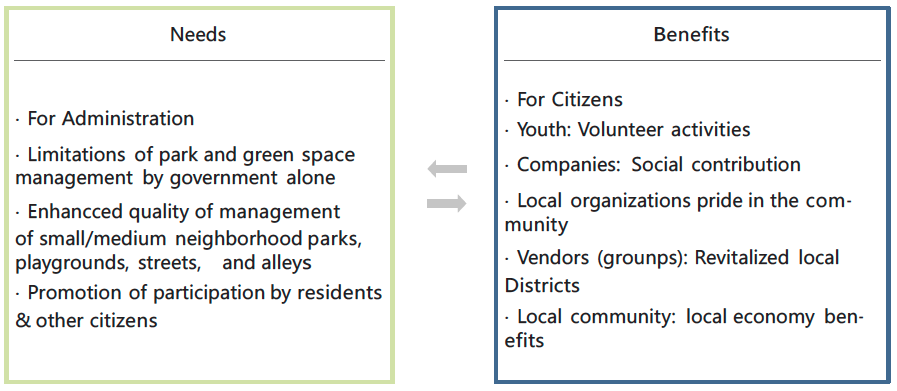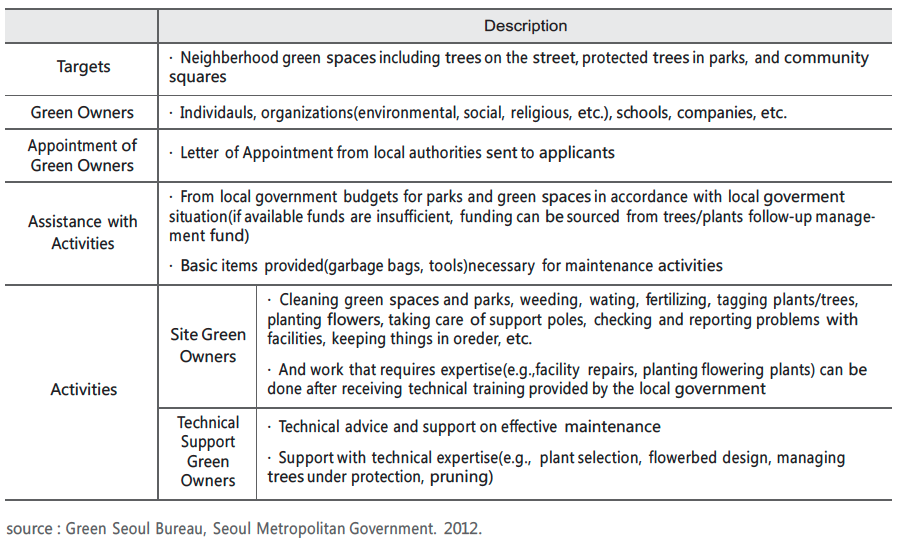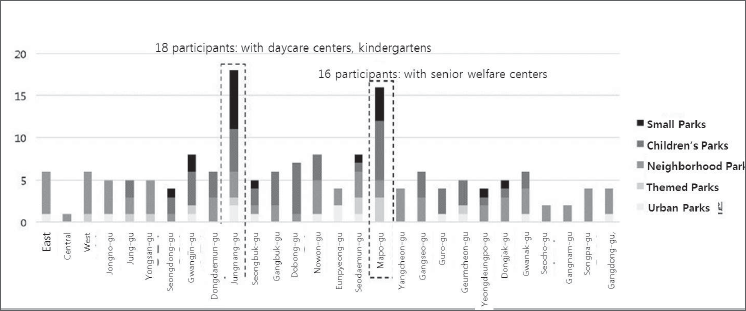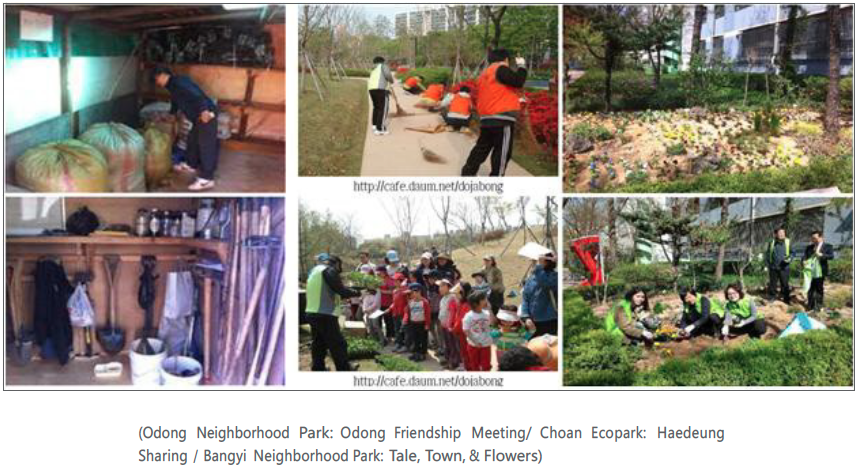Citizens Adoption of Forest & Park Facilities
Background
The public sector is very limited in its ability to employ the staff necessary for proper management of urban parks and spaces, meaning these areas are not managed and maintained at all times. The frequency at which such maintenance is conducted should depend on the use of the surrounding land, but the shortage of manpower and funds have led to garbage piling up, and trees and plants withering and dying. Each district office works under different conditions, resulting in different outcomes. It was against this backdrop that people began calling for a policy that involves individuals, companies, the elderly, and students to assist with management and let the citizenry, not the government, lead the way in resolving these problems.
In August 2012, the 8th Pacific Rim Community Design Network Conference was held, with “Green Community Design” as its theme, introducing examples where citizens were active in turning their communities green. For such publicly-participated projects to grow from simple one-stop measures to lasting policy, innovative ideas and models were needed to minimize trial and error and meet the demands of the people.
In 2003, Seoul introduced a citizen-involved park management system for the creation and management of Seoul Forest where Seoul Green Trust participated in creation and management of Seoul Forest. With the objective of becoming ‘A green city created by its citizens’, Seoul has since applied this new management concept to its urban greening programs. In 2012, the mayor mentioned in the Mayor’s Hope Diary the idea of having urban parks and green spaces adopted by residents. The adoption program was introduced the following year, pursued by the Park & Green Space Policy Department.
<Figure 1> History of Citizen Participation in the Management of Parks in Seoul

Necessity for Park & Green Space Management by Citizens
With residents involved, areas can be reached that government administration has failed to address. For instance, during a drought in 2012, street-side trees were slowly dying, so the gu district offices attached water bags to water the trees. If in this situation there had been a program for citizens to get involved, costs would have been reduced and damage to plants and trees would have been less severe.
<Figure 2> Garbage Dumped Beside Trees & on Green Areas
.jpg)
<Figure 3> Tree Cleaning & Pruning
.jpg)
<Figure 4> Watering Trees during the Drought in 2012
.jpg)
If residents were allowed to participate in the management of parks and green spaces, they could fill the needs that governments cannot address properly. The government would be able to divert money to more essential areas, reduce its costs, and enjoy greater benefits.
Responding to this need, Seoul initiated the ‘Adopt a Tree’ and ‘Adopt a Park’ programs in 2012. From the administrative perspective, citizen participation is useful and even necessary as it will enhance the quality of parks, green spaces, and management of the local environment and revitalize the local culture. Residents also have an opportunity to contribute to society, help boost the local economy, and develop greater pride in the beauty of the local community.
<Figure 4> Necessity for & Benefits of Adoption Programs for Parks & Green Spaces

Adoption of Trees, Plants, & Park Facilities
Residents would donate their time and effort to work with the government in targeting trees, plants, and park facilities where the government is unable to pay adequate attention, as well as other areas where citizens would like to be involved. While residents can “adopt” certain trees, plants, and parks, they do not have ownership, making such programs different from other activities where participants are compensated in any form for the time they give.
Expected Benefits of Park & Green Space Adoption Programs
If these programs prove successful, the quality of park, green space and overall environmental management will increase. There is also potential to advance the local culture. Citizen participation will be especially effective in those areas that are not taken care of due to the lack of manpower. Participating citizens will also have the opportunity to watch over and care for the local environment, helping them develop pride in and a sense of belonging to the neighborhood, with adoption of small local parks particularly resulting in positive responses from local residents. People who participate in the process of maintaining a park feel affection for the place, which in turn motivates them in their management of the park.
<Figure 5> Synergy Created by Adoption of Park & Green Spaces

Elements of Success
For the system to enjoy long-term success, voluntary participation by citizens is critical, and for that to happen, an affection for the place they adopt is necessary, as is consistency. The current adoption programs are far more comprehensive as they embrace elderly employment programs, student volunteer programs, and adoption by civic groups, individuals, and companies, all of which can be personalized by giving the program a friendly, unique name.
<Figure 6> Requirements for Park & Green Space Adoption Programs

Citizen Participation Similar to the Adoption System
<Seoul Green Trust’s Management of Seoul Forest>
Similar to the “Adopt” system, this approach also involves citizen participation and has 2 types of programs: donation and volunteer works.
-Tree Adoption
This program supports maintenance of the trees at Seoul Forest. Participants donate to support the existing trees or the planting of new trees at Seoul Forest, and signs at the trees denote the names of the supporters (300,000 KRW/tree). This gives people something to remember their gift by, to mark a gift for others, or celebrate an event.
-Forest of Sharing
Forest of Sharing was implemented between 2003 and 2005 as a way to create Seoul Forest, until it was opened to the public. Participants donated a certain amount and attended tree-planting ceremonies. The individuals, organizations, and companies who participated in creating the Green Area Fund and the Forest had their names etc. displayed at “their” trees (KRW 300,000 per 3.3 m2).
Some participants adopted a designated area at Seoul Forest and pledged to manage the area on a voluntary basis. The concept of adoption was chosen for the Forest of Sharing program because it does not mean ownership but focuses on continued management and care for the Forest. Companies involved in the adoption send personnel to maintain their areas 6 times a year (20 persons) and display promotional banners on the tree tags. Initial cost of sponsorship is KRW 15 million per 330 m2; in the following year, they pay KRW 1.5 million per 330 m2 for management and a 3-year membership.
-Adopt a Site
‘Adopt a Site’ is a regular volunteer program carried out each season. Details vary according to environmental factors and park status. Seoul Forest Supporters are corporate members who have opened a membership account for KRW 1.5 million and continue to participate in the forest management programs each season.
<Figure 7> Forest of Sharing Certificate & Adopt a Tree Program / Adopt a Site Activity / Seoul Forest Homecoming Day (From Left to Right)
.jpg)
Responsible Green Management (Green Owner System 2000 – 2009)
The Responsible Green Management program was designed to manage street trees, green spaces, community squares, and parks, etc. through voluntary participation. Individuals, organizations or schools who signed up for the program were designated as site or technical support managers, with the central government assisting local government with the basic materials for maintenance activities, identifying “excellent” activities, and giving awards. This program was run for 10 years, peaking in 2004 and 2005. However, funds were insufficient and the program was pushed behind other policies in priority in 2009.
<Table 1> Green Owner System

The ‘Adopt a Green’ Program as one of the Adoption Programs
Adopt a Green
As part of the park and green space adoption program, the “Adopt a Tree” program was piloted in 2012. In the following year, it was expanded to cover parks – the ‘Adopt a Park’ program. This allows organizations and individuals to adopt a park, tree or green area. Upon signing an agreement, participants maintain their designated trees or green spaces.
<Figure 9> Seoul’s ‘Adopt a Green’ Program, Sub-programs, & Activity Types

There are 5 types of activities. The first is part of the effort to create jobs for senior citizens, who clean and beautify the street trees and are paid based on 40 hours of work per month. The second type gives opportunity to students to be involved in learning more about the environment and making a contribution. The hours worked are officially recognized as volunteer activities. The third type is management by civic groups, while the fourth and fifth types are management by individuals and companies, respectively. Of these, the first two are different in their intended purpose and need to be separated from the rest in the future.
While the job program for senior citizens pays wages for hours worked, adoption by school volunteer programs, individuals, civic groups, companies, religious entities, local associations, and educational institutions (kindergartens, daycare centers) do not involve compensation, with participants signing up because they are willing to work without payment.
-Adopt a Tree
The Adopt a Tree program is where citizens and organizations adopt and care for a tree on the street or in a green strip, and is open to schools, individuals, groups, companies, and senior citizens. As part of the jobs for senior citizens program, there is no fixed contract period and senior citizens are employed during designated periods. Religious or senior citizens groups can also participate. Applicants sign a year-long agreement with the local government or program office, which may be extended after an annual assessment.
<Figure 10> Procedure for Participation in the Adopt a Tree Program

Main activities include caring for damaged facilities, removing garbage, weeding, and watering the trees. “Adopt a Tree” signs are installed to indicate the responsible individual or group, and garbage bags, gloves, tongs, and other cleaning supplies are provided. The activity hours are officially recognized as volunteer hours, and the activities may be promoted externally or featured by the media. Adopt a Tree also provides education on the ecosystem.
As a pilot program in 2012, Adopt a Tree was pursued by Seonsa Primary School in Gangdong-gu and by Hanyang University High School in Seongdong-gu on the streets in front of the schools. Senior citizens were also hired for the job program and were engaged in the activities for 4 months.
<Figure 11> “Adopt a Tree” Activities in 2012

<Table 2> Adopt a Tree Pilot Programs in 2012

-Adopt a Park
The Adopt a Park program provides opportunity to the citizens of Seoul to manage their own areas of parks and green spaces, thereby raising environmental and community awareness and establishing a sustainable management system on a voluntary basis. In the program, a park is adopted by a local organization which will clean and beautify it by planting additional trees and flowers. In this way, the program seeks to instill pride and a sense of community ownership.
Religious groups, schools, companies, senior citizens’ groups, and individuals can participate in the Adopt a Park program. As with Adopt a Tree, participants sign an agreement with the local government or program office. The agreement, which contains details on the period, activities and their duration, is a year long and may be extended after an annual assessment. Adopt a Park participants clean their designated park areas, beautify garden beds, and clean up graffiti, etc. They report any damaged or potentially dangerous park facilities and those that no longer operate the way they were intended. The frequency of activities is determined (e.g., weekly, monthly, quarterly) through consultation with participants, who then submit an Application for Park Management Activity 7 days before the desired date, and a Report on Park Management Activity upon completion of each activity.
<Figure 12> Procedure for Participation in the Adopt a Park Program

Adopt a Park group activities are assessed each year. If the results are found to be insufficient, the agreement will not be renewed. The agreement may be terminated if a group fails to comply with rules on park use or management during the agreement period, or if the group requests termination.
At the park, a sign board is installed to indicate groups responsible for park management, and cleaning supplies are provided. Adopt a Park activities can also be officially acknowledged as volunteer work. When a participating group wishes to hold a cultural or talent event, the park may be used as the event venue. The group’s activities may be promoted externally or featured by the media, and the program also provides education programs on the ecosystem, and events such as flower planting.
Adoption Program Outcomes
Up to date, 21 groups are in the Adopt a Park program and have adopted 163 parks – 7% of all parks managed by Seoul. Urban parks or themed parks have higher adoption rates, while most neighborhood parks suffer from a lack of participation. Large parks, themed parks, and urban parks have other programs besides Adopt a Park, making it easier for them to find interested organizations. Applicants in the Adopt a Park program include daycare centers and kindergartens (38, the highest), companies (36), schools (16), religious groups (24), societies (7), clubs (5), welfare centers (18), senior citizens’ centers (4), individuals (7), and “others” (16).
<Figure 13> Participating Groups in the Adopt a Park Program (As of December 2013) (Total: 211 groups)

Interested parties can apply to participate in the Adopt a Park program through the local government or program office. The gu district with the highest number of adopted parks is Jungnang-gu, followed by Mapo-gu.
<Figure 14> Adopted Parks by Gu District (As of December 2013)

Activity Frequency in the Adopt a Park Program
Many participants are involved in the Program on a monthly basis, with a substantial number of people working weekly. Daily participation is rare.
Participating local companies offer expert management and significant levels of activity, but companies or, for instance, daycare centers, only work during a specific time or on a monthly basis, which is not of great help. Community groups have not shown much interest and generally did not submit activity reports on a consistent basis.
Resident Satisfaction with Citizen Participation in Park Management
Site inspections were conducted on 3 outstanding examples (Odong Neighborhood Park, Choan Ecopark, and Bangyi Neighborhood Park) of the Adopt a Park program, and a survey given to which 118 participants responded. The results demonstrated overall satisfaction by the participants and also included areas for improvement.
Most responding program participants live within walking distance of the park, and many have been longtime residents of the area.
Generally, participants were very satisfied with the program, feeling that the park had improved in terms of cleanliness, safety and the overall atmosphere after the Adopt a Park program had begun.
<Table 3> Survey on Effects of Participation Program on Park (N=117) Average (%), Source: Yuk Eun-jeong (2014)

It was found that satisfaction was higher in participants i) who were more attached to the park and the neighborhood; ii) who had proactive group leaders; and iii) who were more motivated about program activities. The sense of achievement and an adequate level of labor from the activity also contributed to the high satisfaction level, as did the opportunity to get together with neighbors and meet new people.
<Figure 15> Activities by Civic Groups (Photo: Yuk Eun-jeong (2014))

References
Kim Won-ju, 2013, Introduction of the Citizen Adoption Program for Forest & Park Facilities in Seoul, The Seoul Institute.
Yuk Eun-jeong, 2014, Study on the Elements of Satisfaction of Participants in the Local Park Management Program – a Focus on Seoul’s ‘Adopt a Park’ Program, Seoul National University Graduate School of Environmental Studies.
Green Seoul Bureau, 2014, Main Project Plan 2014, Seoul Metropolitan Government.
Jo Wi-rae, 2012, Study on the Effect of Attachment to Location on Local Park Management by Citizens, Seoul National University Graduate School of Environmental Studies.